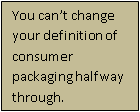There’s no question that the folks at the US-based environmental group, Upstream, have their hearts in the right place. We just wish they would get all of their facts straight.
The group recently launched a wide-ranging campaign against packaging waste, including a section on what it calls paper-based “consumer” packaging. Upstream defines this as pretty much everything except corrugated boxes, and claims that only 25% of it is being recycled in the US[1].
The assumption that corrugated boxes should not be considered part of consumer packaging, however, directly contradicts the 10 years of detailed residential data we have here in Canada. In fact, corrugated boxes are the single largest component (on average 46%) of Canadian consumer paper packaging (containing everything from appliances through to electronics, wine and beer, pizza, even hamburgers)[2]. So it doesn\’t seem very honest to us for Upstream to exclude almost half of residential paper packaging from its calculations. We have no reason to believe that American and Canadian residential consumption patterns are significantly different.

Excluding corrugated from one’s definition of consumer packaging, of course, makes a huge difference in the recycling rate. In Canada, more than 80% of these “consumer” corrugated boxes are being recovered for recycling[3]. We don’t know the equivalent rate for the US, but Upstream’s claim of only 25% recovery (by excluding residential corrugated) gives a very misleading impression to say the least[4].
This false impression is compounded when Upstream tries to calculate the supposed environmental impact of the “consumer” packaging that ends up in landfill, what it calls “a waste of forests.” For some reason, Upstream does not use the US EPA discard total for non-corrugated paper packaging (6.42 million tons), which would be consistent with its limited definition of consumer packaging.

Instead it uses a tonnage number that’s almost 30% higher (the discard total for corrugated and non-corrugated packaging from both industrial and residential sources)[5]. In effect, what Upstream has done is ignore residential corrugated when discussing the recovery rate, but include residential (and industrial-sourced corrugated) when it calculates waste. You can’t do that! You can’t change your definition of consumer packaging halfway through without inviting criticism that you are deliberately distorting the numbers to make your target (paper-based consumer packaging) look worse.
Even if you buy Upstream’s argument of a “waste of forests” (we don’t, and will explain why in a later blog), correcting this statistical miscalculation would shrink the size of that “forest” by almost a third. We suggest that Upstream do the honourable thing and remove its “Waste of Forests” piece from both its website and its campaign while it corrects these errors.
_______________________________________________________________________________________________________________________________
[1] Upstream’s Make It, Take It Campaign, A Waste of Forests, claims that “only 25% of paper-based consumer packaging is recycled.” This ties in with Table 4, Paper and Paperboard Products in Municipal Solid Waste in the United States: Facts and Figures, 2012 (US EPA) which cites a recovery rate for paper packaging (excluding corrugated boxes) of 24.7%.
[2] Stewardship Ontario data for Ontario’s residential Blue Box program (2003 to 2012). Residential corrugated averaged 46% of all residential (consumer) paper packaging generation over a 10-year period.
[3] Stewardship Ontario, ibid. The recovery rate for residential corrugated over the same period averaged 81% (85% in the latest data year).
[4] Table 4 above (US EPA) cites a corrugated recovery rate in the US of 90.9% but there is no breakdown of recovery by consumer or industrial source.
[5] Upstream claims that “only 25% of paper-based consumer packaging is recycled. The rest – 9.1 million tons is wasted each year….” But according to the US EPA (Table 4 above), the discards of Upstream’s chosen definition of “consumer” packaging (excluding corrugated) was only 6.42 million tons. Upstream inflated its waste calculation by 29 per cent.
